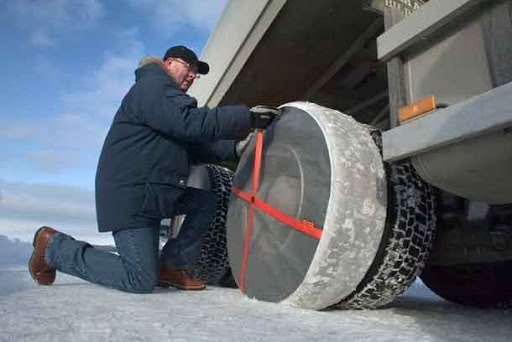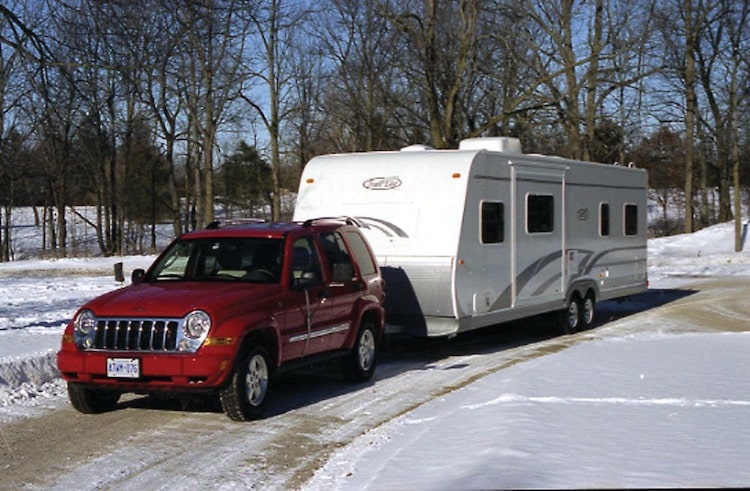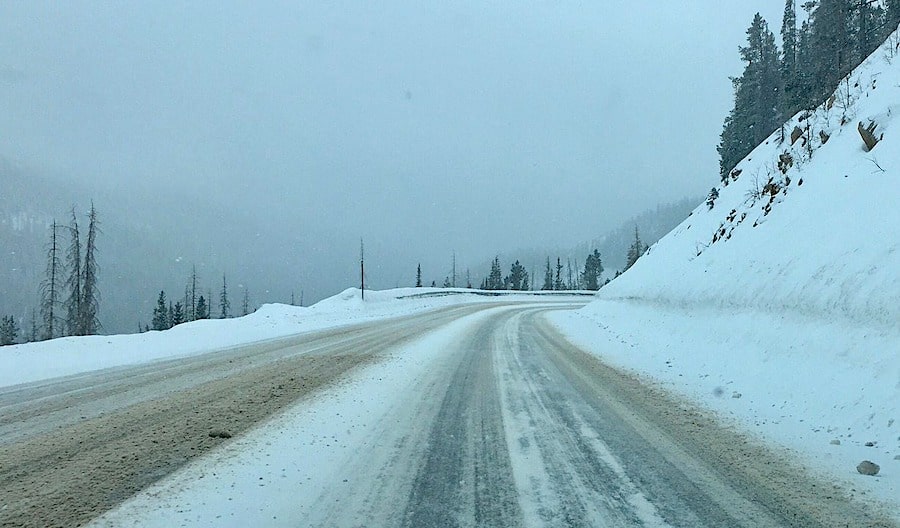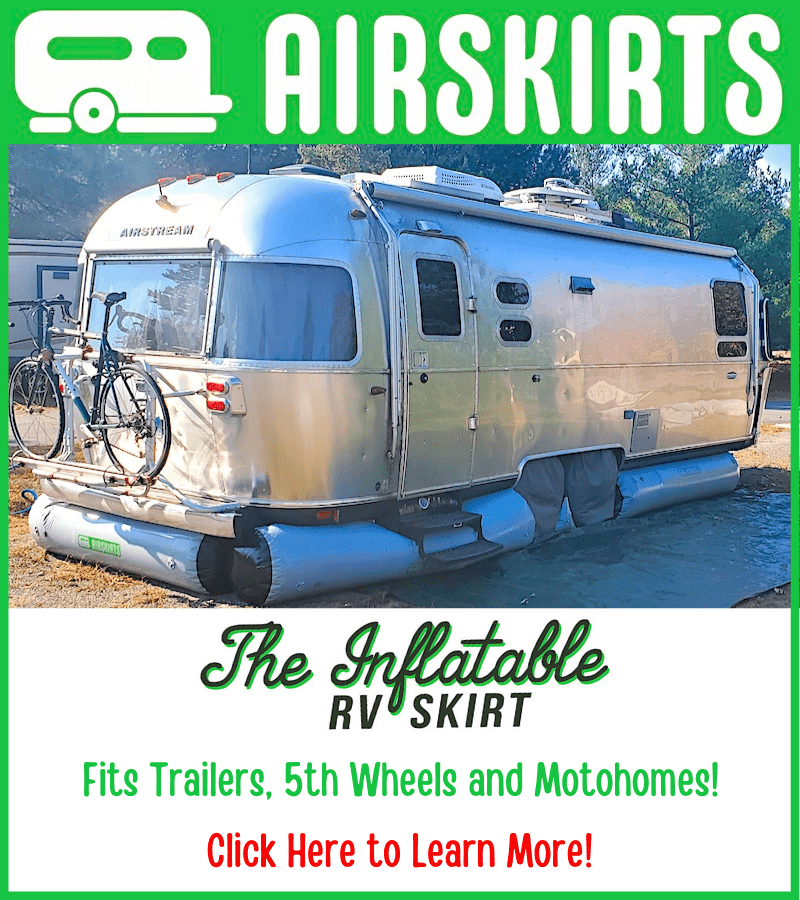Thanks for your support! If you make a purchase using our links in this article, we may make a commission. And, as an Amazon Associate, I earn from qualifying purchases. See the full disclosure here.
For many people, the first snowfall of the season means packing up the RV and storing it until the spring. For others, it’s time to change out the lounge chairs for ski equipment in the storage bays. You need to know how to drive your RV in the snow to get to your winter destination safely.
There are ways to prepare yourself and your RV to minimize your risk when driving on snow and ice. Special tires and grip aids can prevent you from drifting off the road. If you do become stuck on the side of the road, having the right emergency equipment could save your life.
General Rules for Driving an RV in Snow
If this is the first time you’ve ever driven your RV in snow, there are some basic perspectives you need to understand about traveling in winter. Here are some basic tips to help you make your way through the snow-covered roadways.
- Rolling Stops: When you stop at an intersection, slamming on the brakes results in sliding. Your wheels will lock up and your momentum will keep you moving. Instead, apply half pressure to your brakes to keep your wheels rolling to slow to your desired stop point.
- Keep Plenty of Space Infront of You: In the best conditions, braking takes longer than average due to your weight. With snow and ice, expect to double or triple that length with the slippery conditions.
- Drive slowly: Your RV is top-heavy and susceptible to wind shears. To avoid ending up in a ditch due to fishtailing, keep to a comfortable pace. Most highways have a minimum speed of 45 mph, but in bad conditions, you’re allowed to go even slower.
- Slow Wide Turning: This is especially important with travel trailers in winter. The key concept is to make sure the RV stays on track during the turn. You don’t want it to hit an ice patch and skid wideout into other lanes of traffic.
Prepare Before You Drive Your RV in Snow and Ice
Plan Ahead
As you plan your trip, spend some time looking up road conditions and weather reports. In the Snowbelt, you won’t have to deal with “orange cone season” (the slang for construction) during the winter months. Some roadways get particularly rough due to ice and snow.
AAA or state authorities may suggest alternative routes that are generally safer to travel. Certain routes may prohibit semi-trucks and RVs to drive through during this time of year, so you want to be aware of this ahead of time. Too often, travelers find out too late and end up stuck on those roads for miles until they can find the first exit to turn around.
Snow Tires
There are different tires you can purchase that will help you with traction. RV snow tires do exist for travel trailers, but you’ll have an easier time finding all-terrain versions. The difference between the two comes down to the rubber material and the tread.
Winter tires stay soft and pliable in cold temperatures. The treads have more gripping surfaces than other tires. Generally, snow tires have lower air pressure so there is more tire surface on the road.
All-terrain tires are more firm but still have gripping treads. They’re meant to keep traction on rock and dirt, but do perform decently through the snow. Compared to regular tires, you won’t get as much slipping on ice.
Some people have tried putting car tires on their RV. It’s not a good idea to do this. RV tires work together with the suspension to absorb the shock of road conditions, so there are different components built within the tire.
Car tires don’t have this feature. They rely on the vehicle’s suspension to do all of the work. If you do put car tires on your RV, both your coach and the tires could end up failing at the worst time of your trip.
Motorhomes, especially class A diesels, use bus and semi-truck tires. Finding tire alternatives are especially difficult. The best place to start is your RV dealer.
If you are considering changing out your tires for winter use, there are websites you can order from or your RV dealer may have them in stock.
Snow Chains, Socks, and Cables

In certain parts of the country, allow RV snow chains during the winter months or rainy conditions. Using tire chains or cables while driving your class a motorhome in snow gives you a superior grip through snow-covered roads. The problem with them is the damage they do to the road. That’s why it’s illegal to use them on paved roads.
States that allow tire chains will have signs posted stating when and where they are acceptable. Some areas required them at certain times of the year, others allow drivers to use them at their own discretion. The best way to know is to check the state’s website ahead of time or call their department of transportation.
An alternative to tire chains is Autosocks. This company created a fabric that fits over your tires to help with traction in wet, snowy, or icy conditions. When the fabric gets wet, it becomes sticky. The treads of your tires still work through the fabric with the added bonus of the sticky layer from the Autosocks.
Snow socks come in many different sizes. If your travel trailer needs snow chains or your class C RV is in snowy conditions, but can’t use chains, there are sizes available for all of them. They are more difficult to put on than snow chains, so having an extra person with you is always advisable.
Most states are approving their use since they don’t damage roadways. You’ll want to use them sparingly. After 300-400 miles, the pavement and dirt roads do eventually rip through the fabric.
For optimal use, the manufacturer recommends you don’t go faster than 30 miles an hour when the Autosocks are on your tires. They may slow you down, but the real advantage is the ability to have the added traction on roads where tire chains are not permitted.

Be Prepared in Case Your RV Gets Stuck in the Snow
Nobody wants to think about it, but the chance of skidding off the road is a real possibility. Even if you’re traveling on populated roads, you still want to have an emergency kit put together. The main components should deal with equipment to pull you back on the road, road hazard devices, and personal health concerns.
Getting Back on the Road
In one of your exterior bays, you should have heavy-duty tow chains, jumper cables, tools to change a flat tire, and other equipment. You may want to have a cell phone booster installed on your RV in case you get stuck in a signal dead zone.
Average tow trucks can pull cars and SUVs to safety. When you call for help, you need to let them know what type of vehicle and RV you have. The tow truck company may have to send a heavy-duty tow truck that has the capability to pull you out.
Having your own tow chains betters your chances of getting pulled out. The tow truck operator should have what they need, but every situation is unique. Your vehicle and RV could be further down in the ditch than what they’re prepared for or other X-factors.
The point is, when you’re winter camping, there’s no such thing as being over-prepared. Having jumper cables can mean the difference in spending your trip stuck on the side of the road, or getting to your destination.
Keep an Emergency Roadside Kit Onboard
The best emergency roadside kits have orange reflective triangles, road flares, and other components that are the best way to flag someone down to help you. It’s also required by law. Did you know that some people have received a violation ticket since they didn’t have the proper road hazards up while they were stuck?
The road hazard equipment not only signals people that you’re in distress, but it also creates a safety barrier for you and others helping you to walk around. If your problem is fixable on location, the repair specialist needs room to work safely.
Emergency Survival Gear
When you’re stuck, the first thing you need to do is make sure everyone is okay. A full first aid kit must be well-stocked to tackle almost any situation until help arises. Once everyone is safe, there are roads in this country that still take a significant amount of time for first responders to get to.
Having emergency food kits that are either freeze-dried or non-perishable can keep you and your family comfortable until help arrives. With the temperatures being so low, you won’t be able to use your fresh water tank. Instead have insulated water jugs with you to stay hydrated.
You’ll want to avoid using your propane in case any of the connections became damaged. Having a portable electric heater that plugs into your electricity will keep all of you warm, assuming your house batteries are okay.
Driving Your RV in the Snow and Ice
There are more opportunities to RV in the winter than ever before. Ski lodges now have RV parking with electrical hookups and excellent bathhouses that are the same standard as the resort itself. State parks and private campgrounds are staying open all year for those that enjoy snowmobiling and winter sports. The Ice House RV category is expanding for those that enjoy ice fishing.
As you get ready for your winter RV adventure, plan ahead, and make sure you have all the necessary equipment in case disaster strikes. While you’re driving, take it slow and steady. Happy Trails.




